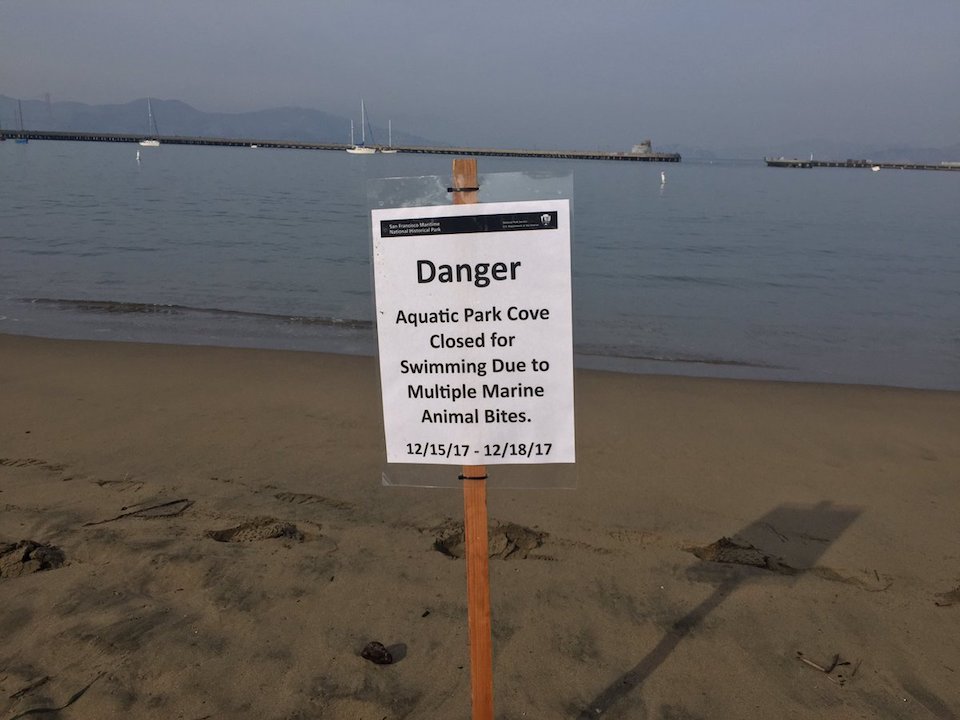
In the last day, at least three people have been bitten by a sea lion while swimming in the waters in and around Aquatic Park near Fisherman's Wharf.
After rescuing a man this morning, SFFD warned the public to avoid entering the water where the incidents occurred; later, the Golden Gate National Park Service closed the area off to swimmers.

On Thursday afternoon, SFPD's Marine 7 assisted a male swimmer who was taken to the trauma center at San Francisco General Hospital after suffering serious arm injuries. As of this morning, he is in good condition, hospital spokesperson Brent Andrew told us.
Hoodline content partner ABC7 spoke to the victim last night, who was identified as Christian Einfeldt. "I did feel threatened, I did have warning, but I was a quarter mile from shore, there was nothing I could do," he told ABC7 .
After a sailboat picked him up and radioed for help, SFPD Officer Matthew Reiter applied a tourniquet to stop the bleeding when it arrived at Pier 45.
A second man suffered non-life threatening injuries this morning, but officials have not yet confirmed details about the third biting incident.
2nd sea lion attack at Aquatic Park in less than 24 hours. Swimmers say they saw paramedics take injured man away. @abc7newsbayarea pic.twitter.com/4SCKZgfvYv
— Carlos Saucedo (@Carlos_Saucedo) December 15, 2017
A spokesperson from the Marine Mammal Center in Sausalito referred us to a paper about bites and contact abrasions that concluded sea lion attacks on open-water swimmers "were infrequent, and given the dozens of people that swim in San Francisco Bay each day, the chances of a negative interaction with a marine mammal are small."
Animals may bite when sick, injured or protecting their young, and others may be curious, but unless biologists can track a biting animal for further study, there's no way to conclude what may have triggered their aggression, said MMC.
When we reached Reuben Hechanova, president of Dolphin Club, he recalled a number of incidents about a decade ago when pinnipeds bit members of the swimming and boating club.
"The two that are typically seen in Aquatic Park are the California sea lion and harbor seals, and are often seen up and about the cove and especially closer to the piers where fishermen occasionally lose their catch to a seal," he said.
Because Aquatic Park is both the animal's domain and a water park for humans, sea lion-human encounters are inevitable, he added.
With this in mind, the club has encouraged members to swim in pairs, stick to shallow areas where they can stand, "and exit the water in the event an encounter occurs," said Hechanova.
Sea lions have four large canine teeth, as well as incisors and cheek teeth that help the animals grab and tear flesh, which give them a fearsome bite. Afterwards, victims can fall prey to a condition called "seal finger," a bacterial infection that can penetrate joints and lead to arthritis and cellulitis.
Swimmers and divers are generally advised to remain 50 yards from free swimming seals and sea lions, as well as animals hauled out on buoys.
Einfeldt told ABC7 that he believes the sea lion trailed him as he swam from the beach to the mouth of Aquatic Park. When he turned around to head back, the sea lion was right there.









